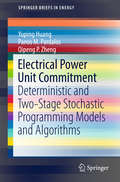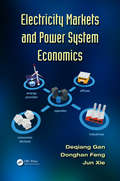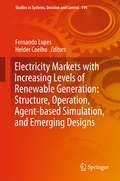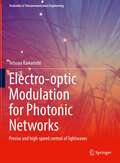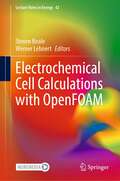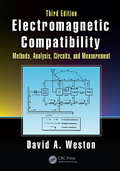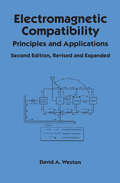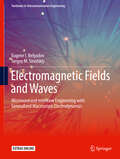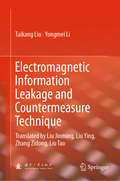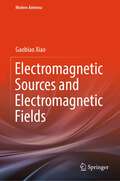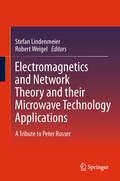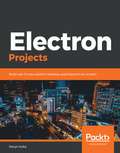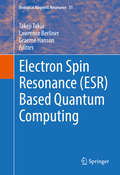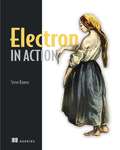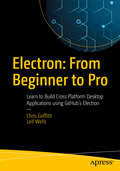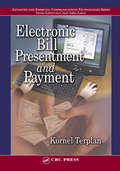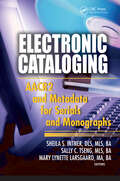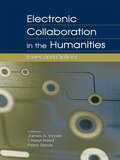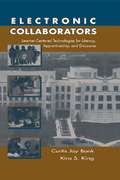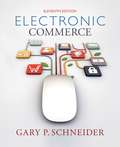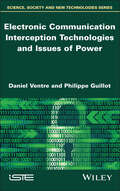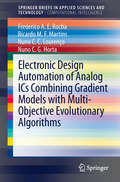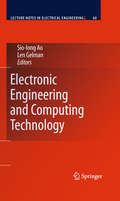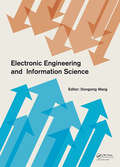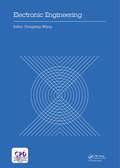- Table View
- List View
Electrical Power Unit Commitment
by Panos M. Pardalos Qipeng P. Zheng Yuping HuangThis entry into the SpringerBriefs in Energy series offers a systematic review of unit commitment (UC) problems in electrical power generation. This book updates texts written in the late 1990s and early 2000s by including both basics of UC models and state-of-the-art models and solution algorithms, where stochastic models and mixed integer programming techniques are emphasized The UC problems are mostly formulated as mixed integer linear programs, although there are many variants. Some of the varieties of algorithms have been developed for or applied to UC problems include dynamic programming, Lagrangian relaxation, general mixed integer programming algorithms, and Benders decomposition. This book also discusses the recent trends in solving UC problems, especially stochastic programming models, and advanced techniques to handle large numbers of integer decision variables due to scenario propagation.
Electricity Markets and Power System Economics
by Deqiang Gan Donghan Feng Jun XieAfter the first power plant in history was commissioned for commercial operation by Thomas Edison on Pearl Street in New York in 1882, electricity was sold as a consumer product at market prices. After a period of rapid development, electricity had become such a fundamental product that regulation was believed to be necessary. Since then, the power
Electricity Markets with Increasing Levels of Renewable Generation: Structure, Operation, Agent-based Simulation, and Emerging Designs
by Fernando Lopes Helder CoelhoThis book describes the common ground between electricity markets (EMs) and software agents (or artificial intelligence generally). It presents an up-to-date introduction to EMs and intelligent agents, and offers a comprehensive description of the research advances and key achievements related to existing and emerging market designs to reliably and efficiently manage the potential challenges of variable generation (VG). Most EMs are unique in their complex relationships between economics and the physics of energy, but were created without the notion that large penetrations of variable generation (VG) would be part of the supply mix. An advanced multi-agent approach simulates the behavior of power markets over time, particularly markets with large-scale penetrations of renewable resources. It is intended as a reference book for researchers, academics and industry practitioners, but given the scope of the chapters and the highly accessible style, the book also provides a coherent foundation for several different graduate courses.
Electro-optic Modulation for Photonic Networks: Precise and high-speed control of lightwaves (Textbooks in Telecommunication Engineering)
by Tetsuya KawanishiThis textbook provides comprehensive and detailed information on electro-optic modulation, which plays important roles in lightwave networks including optical fiber links, visible ray communications, fiber-wireless, etc. The first part of this book describes roles and basic functions of optical modulators as well as various modulation schemes. The second part is on mathematical expressions dedicated to optical modulation, where sideband generation are clearly described. In conclusion, this book provides useful information for device and system technologies, and helps in understanding fundamental issues on telecommunication systems as well as electro-optic devices. Contents in this book provide valuable information for engineering students in telecommunications. It also gives useful examples of applied mathematics using Bessel functions. It is ideal for upper undergraduate and graduate level classes.Provides comprehensive mathematical expressions dedicated to optical phase modulation based electro-optic effect;Presents practical knowledge of optical modulators as well as basic theory on modulator operation;Includes classroom materials including software and PowerPoint slides for easy integration into curriculum.
Electrochemical Cell Calculations with OpenFOAM (Lecture Notes in Energy #42)
by Steven Beale Werner LehnertThis unique book is at the nexus of modern software programming practices and electrochemical process engineering. It is the authoritative text on developing open source software for many applications, including:• fuel cells;• electrolyzers; and• batteries.Written by experts in the field in the open source computational fluid dynamics (CFD) code suite OpenFOAM, this book is intended for process engineering professionals developing practical electrochemical designs for industry, as well as researchers focused on finding tomorrow’s answers today. The book covers everything from micro-scale to cell-scale to stack-scale models, with numerous illustrations and programming examples. Starting from a clear explanation of electrochemical processes and simple illustrative examples, the book progresses in complexity through a range of diverse applications. After reading this book, the reader is able to take command and control of model development as an expert. The book is aimed at all engineers and scientists with basic knowledge of calculus and programming in C++.
Electromagnetic Compatibility: Methods, Analysis, Circuits, and Measurement, Third Edition
by David A. WestonRevised, updated, and expanded, Electromagnetic Compatibility: Methods, Analysis, Circuits, and Measurement, Third Edition provides comprehensive practical coverage of the design, problem solving, and testing of electromagnetic compatibility (EMC) in electrical and electronic equipment and systems. This new edition provides novel information on theory, applications, evaluations, electromagnetic computational programs, and prediction techniques available. With sixty-nine schematics providing examples for circuit level electromagnetic interference (EMI) hardening and cost effective EMI problem solving, this book also includes 1130 illustrations and tables. Including extensive data on components and their correct implementation, the myths, misapplication, misconceptions, and fallacies that are common when discussing EMC/EMI will also be addressed and corrected.
Electromagnetic Compatibility: Principles and Applications, Second Edition, Revised and Expanded (Electrical and Computer Engineering #Vol. 73)
by David WestonThis totally revised and expanded reference/text provides comprehensive, single-source coverage of the design, problem solving, and specifications of electromagnetic compatibility (EMC) into electrical equipment/systems-including new information on basic theories, applications, evaluations, prediction techniques, and practical diagnostic options for preventing EMI through cost-effective solutions.Offers the most recent guidelines, safety limits, and standards for human exposure to electromagnetic fields!Containing updated data on EMI diagnostic verification measurements, as well as over 900 drawings, photographs, tables, and equations-500 more than the previous edition-Electromagnetic Compatibility: Principles and Applications, Second Edition:
Electromagnetic Fields and Waves: Microwave and mmWave Engineering with Generalized Macroscopic Electrodynamics (Textbooks in Telecommunication Engineering)
by Sergey M. Smolskiy Eugene I. NefyodovThis textbook is intended for a course in electromagnetism for upper undergraduate and graduate students. The main concepts and laws of classical macroscopic electrodynamics and initial information about generalized laws of modern electromagnetics are discussed, explaining some paradoxes of the modern theory. The reader then gets acquainted with electrodynamics methods of field analysis on the basis of wave equation solution. Emission physics are considered using an example of the Huygens-Fresnel-Kirchhoff canonic principle. The representation about strict electrodynamics task statement on the base of Maxwell equations, boundary conditions, emission conditions and the condition on the edge is given. Different classes of approximate boundary conditions are presented, which essentially simplify understanding of process physics. The canonic Fresnel functions are given and their generalization on the case of anisotropic impedance. The free waves in closed waveguides and in strip-slotted and edge-dielectric transmission lines are described. A large number of Mathcad programs for illustration of field patterns and its properties in different guiding structures are provided. The material is organized for self-study as well as classroom use.
Electromagnetic Information Leakage and Countermeasure Technique: Translated by Liu Jinming, Liu Ying, Zhang Zidong, Liu Tao
by Taikang Liu Yongmei LiThis book presents a model of electromagnetic (EM) information leakage based on electromagnetic and information theory. It discusses anti-leakage, anti-interception and anti-reconstruction technologies from the perspectives of both computer science and electrical engineering. In the next five years, the threat posed by EM information leakage will only become greater, and the demand for protection will correspondingly increase. The book systematically introduces readers to the theory of EM information leakage and the latest technologies and measures designed to counter it, and puts forward an EM information leakage model that has established the foundation for new research in this area, paving the way for new technologies to counter EM information leakage. As such, it offers a valuable reference guide for all researchers and engineers involved in EM information leakage and countermeasures.
Electromagnetic Sources and Electromagnetic Fields (Modern Antenna)
by Gaobiao XiaoThis book presents a modified spherical harmonic expansion method in which the electromagnetic fields and their sources are expanded with the same set of spherical vector basis functions in a similar procedure. Explicit expressions for the electromagnetic fields, potentials, energies, and the related Green’s functions are derived for the spherical modes in both frequency domain and time domain. Based on the formulation, the relationships between the electromagnetic sources, the electromagnetic far fields, and the electromagnetic near fields are clearly revealed. In particular, a nonuniform transmission line model is developed for intuitively characterizing the total radiation process. The introduction of the cutoff radius and the cutoff mode degree provides a simple reference for determining the numbers of degrees of freedom of the fields associated with sources in a bounded region. Based on the theory, an efficient hybrid method for synthesizing antenna arrays with complex footprints is proposed and demonstrated with several numerical examples. Effective algorithms are also developed for reconstructing the radiating part of the current sources.This book is intended for researchers, engineers, and graduate students who are interested in studying the energy transfer in electromagnetic radiation, synthesis and measurement of antenna arrays, and applications of inverse electromagnetic source problems.
Electromagnetics and Network Theory and their Microwave Technology Applications
by Robert Weigel Stefan LindenmeierThis volume provides a discussion of the challenges and perspectives of electromagnetics and network theory and their microwave applications in all aspects. It collects the most interesting contribution of the symposium dedicated to Professor Peter Russer held in October 2009 in Munich.
Electron Projects: Build over 9 cross-platform desktop applications from scratch
by Denys VuikaThe book aims at JavaScript developers who want to explore the Electron framework for building desktop apps. The book assumes working knowledge with modern front-end JS frameworks and Node.js. No prior knowledge of desktop development required.
Electron Spin Resonance (ESR) Based Quantum Computing
by Lawrence Berliner Takeji Takui Graeme HansonThis book addresses electron spin-qubit based quantum computing and quantum information processing with a strong focus on the background and applications to EPR/ESR technique and spectroscopy. It explores a broad spectrum of topics including quantum computing, information processing, quantum effects in electron-nuclear coupled molecular spin systems, adiabatic quantum computing, heat bath algorithmic cooling with spins, and gateway schemes of quantum control for spin networks to NMR quantum information. The organization of the book places emphasis on relevant molecular qubit spectroscopy. These revolutionary concepts have never before been included in a comprehensive volume that covers theory, physical basis, technological basis, applications, and new advances in this emerging field. Electron Spin Resonance (ESR) Based Quantum Computing, co-edited by leading and renowned researchers Takeji Takui, Graeme Hanson and Lawrence J Berliner, is an ideal resource for students and researchers in the fields of EPR/ESR, NMR and quantum computing. This book also * Explores methods of harnessing quantum effects in electron-nuclear coupled molecular spin systems * Expertly discusses applications of optimal control theory in quantum computing * Broadens the readers' understanding of NMR quantum information processing
Electron in Action
by Steve KinneySummaryElectron in Action guides you, step-by-step, as you learn to build cross-platform desktop applications that run on Windows, OSX, and Linux. By the end of the book, you'll be ready to build simple, snappy applications using JavaScript, Node, and the Electron framework.Purchase of the print book includes a free eBook in PDF, Kindle, and ePub formats from Manning Publications.About the TechnologyWouldn't it be great to build desktop applications using just your web dev skills? Electron is a framework designed for exactly that! Fully cross-platform, Electron lets you use JavaScript and Node to create simple, snappy desktop apps. Spinning up tools, games, and utilities with Electron is fast, practical, and fun!About the BookElectron in Action teaches you to build cross-platform applications using JavaScript, Node, and the Electron framework. You'll learn how to think like a desktop developer as you build a text tool that reads and renders Markdown. You'll add OS-specific features like the file system, menus, and clipboards, and use Chromium's tools to distribute the finished product. You'll even round off your learning with data storage, performance optimization, and testing. What's insideBuilding for macOS, Windows, and LinuxNative operating system APIsUsing third-party frameworks like ReactDeploying to the Mac App StoreAbout the ReaderRequires intermediate JavaScript and Node skills. No experience building desktop apps required.About the AuthorSteven Kinney is a principal engineer at SendGrid, an instructor with Frontend Masters, and the organizer of the DinosaurJS conference in Denver, Colorado.Table of ContentsPART 1 - GETTING STARTED WITH ELECTRON Introducing Electron Your first Electron application PART 2 - BUILDING CROSS-PLATFORM APPLICATIONS WITH ELECTRONBuilding a notes application Using native file dialog boxes and facilitating interprocess communication Working with multiple windows Working with files Building application and context menus Further operating system integration and dynamically enabling menu items Introducing the tray module Building applications with the menubar library Using transpilers and frameworks Persisting use data and using native Node.js modules Testing applications with Spectron PART 3 - DEPLOYING ELECTRON APPLICATIONS Building applications for deploymentReleasing and updating applications Distributing your application through the Mac App Store
Electron: From Beginner to Pro
by Chris Griffith Leif WellsDiscover how to take your existing web development skills and learn how to create desktop applications for macOS, Windows, and Linux, using GitHub's Electron. Learn how to combine the power of Node. js and Chromium to provide a powerful development platform for creating web applications that break free from the browser. Electron: From Beginner to Pro guides you through the capabilities that you have available to create desktop applications. Learn to use features like file system access, create native menus, OS-specific dialogs and more. The authors will show you how to package your application for distribution for multiple platforms and enable auto-updating. What You Will Learn Leverage your knowledge of HTML, CSS and JavaScript Use current web applications for the desktop Create and use Electron's main process and render process to create effective desktop applications Communicate between processes and between windows Build desktop applications that can be updated and distributed Who This Book Is For Web developers looking to leverage their HTML, CSS and JavaScript skills to create desktop widgets and applications. Developers wanting to leverage existing a Web application to extend functionality with a desktop application.
Electronic Bill Presentment and Payment
by Kornel TerplanElectronic bill presentment and payment (EBPP) is revolutionizing the billing process by offering online and real time presentment of bill content and payment choices. EBPP is the easy way of viewing billing status, remittance items, and presenting balances using a universal browser from any location. In contrast to paper-based bills, electronic bi
Electronic Cataloging: AACR2 and Metadata for Serials and Monographs
by Sheila S. Intner Sally C. Tseng Mary Lynette LarsgaardExamine some of the most recent developments in bibliographic control! Electronic Cataloging: AACR2 and Metadata for Serials and Monographs is a collection of papers about recent developments in metadata and its practical applications in cataloging. Acknowledged experts examine a wide variety of techniques for managing serials and monographs using standards and schemas like MARC, AACR2, ISSN, ISBD, and Dublin Core. From the broadest introduction of metadata usage to the revisions of AACR2 through 2000, this book offers vital analysis and strategy for achieving Universal Bibliographic Control. Electronic Cataloging is divided into three parts. The first is an introduction to metadata, what it is, and its relationship to the library in general. The second portion focuses in more on how metadata can be utilized by a library system and the possibilities in the near future. The third portion is very specific, dealing with individual standards of metadata and elements, such as AACR2 and MARC, as well as current policies and prospects for the future. Information covered in Electronic Cataloging includes: an overview of metadata and why it is important to the cataloging community Universal Bibliographic Control: what has succeeded so far in cataloging and how metadata will evolve the step-by-step process for creating an effective metadata repository for the community the inherent problems that accompany cataloging nonprint research materials, such as electronic serials and the Web metadata schemas and the use of controlled vocabularies and classification systems standards of metadata, including MARC, Dublin Core, RDF, and AACR2, with emphasis on the revisions and efforts made with AACR2 through 2000 an overview of the ISSN (International Serials Standard Number) and its relationships to current codes and metadata standards, including AACR2 and much more! Electronic Cataloging is the undertaking of three pioneers in library sciences: Sheila S. Intner, Sally C. Tseng, and Mary L. Larsgaard, who co-edited Maps and Related Cartographic Materials: Cataloging, Classification, and Bibliographic Control (Haworth, 2000). With illustrations, references, additional reading lists, and case studies, this research tool offers you tips and strategies to make metadata work for you and your library. No one currently involved in information cataloging should be without this book!
Electronic Collaboration in the Humanities: Issues and Options
by James A. Inman Cheryl Reed Peter SandsThis volume provides an informed view of how information technology is shaping the contemporary humanities. It specifically reflects five ideals:*humanities scholars with all levels of access are doing important work with technology;*humanities scholars' projects with technology reflect significant diversity, both across and within disciplinary bounds;*using information technology in the humanities is a continuous conversation;*information technology offers new options for humanities education; and *just as collaboration changes the nature of any project, so does information technology change the nature of collaboration--its speed, character, methods, and possible implementations.The first to explore new and important ways for humanities scholars to collaborate across disciplines via electronic media, this book redefines electronic collaboration; presents insightful models of student collaboration; provides important models of faculty collaboration with special emphasis on professional development; and offers a look at the future of electronic collaboration and the overall future of the humanities. Featuring the voices of humanities teacher-scholars at all stages of their professional careers, the chapters emphasize pedagogy, outlining contemporary issues and options.Electronic Collaboration in the Humanities speaks directly to anyone involved with interdisciplinary initiatives in colleges and universities, such as writing across the curriculum and communication across the curriculum programs, and to specific populations within the humanities, including literacy and technology, language and literature, literacy studies, professional writing, and English education.
Electronic Collaborators: Learner-centered Technologies for Literacy, Apprenticeship, and Discourse
by Curtis Jay Bonk Kira S. KingTwo developments in recent years have converged to dramatically alter most conceptions of the teaching and learning process. First, technology has become increasingly interactive and distributed, such that individual learners have available the means to participate in incredibly complex networks of information, resources, and instruction. As these technological advancements facilitate interaction across classroom, university, and worldwide learning communities in both real-time and delayed formats, various instructional design and implementation problems spring forth. Second, the conventional teacher-centered model wherein knowledge is transmitted from the teacher to the learner is being replaced by social constructivist and learner-centered models of instruction. These new learner-centered models place emphasis on guiding and supporting students as they meaningfully construct their understanding of various cultures and communities. As a consequence of these developments, teachers need guidelines from educational researchers about integrating collaboration and communication tools into their classrooms. This volume presents research on such collaborative technology as it facilitates, augments, and redefines academic learning environments. The studies illustrate how schools, teachers, and students are discovering, employing, and modifying the numerous new computer conferencing and collaborating writing tasks and tools, and their effects on social interaction and resulting student learning. Documentation is given that will help teachers to make decisions that productively transform learning environments. Three key objectives underlie this volume: *to discover some of the electronic collaboration tools and formats currently employed by teachers in schools and universities and to situate these within a five-level taxonomy of computer conferencing and collaborative writing tools and approaches; *to examine some of the sociocultural learning variables embedded in the use of electronic collaborative tools and approaches; and *to participate in a dialogue about the importance of student electronic social interaction and dialogue from a sociocultural perspective. This is a must-read volume for all researchers, scholars, graduate students, and practitioners interested in such fields as sociocultural theory, process writing, cooperative learning, learner-centeredness, distance education, peer conferencing and tutoring, mentoring, electronic collaboration, problem- and project-based learning, collaborative writing, and educational reform.
Electronic Commerce
by Gary P. SchneiderPacked with real-world examples and business cases, ELECTRONIC COMMERCE, 11E continues to lead the market with its cutting-edge coverage of all things e-commerce. Comprehensive coverage of emerging online business strategies, up-to-the-minute technologies, and the latest developments from the field equips readers with a solid understanding of the dynamics of this fast-paced industry. The new edition offers thorough discussions of e-commerce growth in China and the developing world, social media and online marketing strategies, technology-enabled outsourcing, online payment processing systems, and much more. In addition, "Business Case Approaches" and "Learning From Failure" boxes highlight the experiences of actual companies to illustrate real-world practice in action.
Electronic Communication Interception Technologies and Issues of Power
by Daniel Ventre Philippe GuillotIn cyberspace, data flows transit massively and freely on a planetary scale. The generalization of encryption, made necessary by the need to protect these exchanges, has resulted in states and their intelligence services forgoing listening and interception missions. The latter have had to find ways to break or circumvent this protection. This book analyzes the evolution of the means of communication and interception, as well as their implementation since the advent of the telegraph in the 19th century. It presents this sensitive subject from a technical, historical and political perspective, and answers several questions: who are the actors of interception? Who has produced the recent technologies? How are the markets for interception means organized? Are the means of protecting communications infallible? Or what forms of power do interceptions confer?
Electronic Design Automation of Analog ICs combining Gradient Models with Multi-Objective Evolutionary Algorithms
by Nuno C.G. Horta Frederico A.E. Rocha Ricardo M.F. Martins Nuno C.C. LourençoThis book applies to the scientific area of electronic design automation (EDA) and addresses the automatic sizing of analog integrated circuits (ICs). Particularly, this book presents an approach to enhance a state-of-the-art layout-aware circuit-level optimizer (GENOM-POF), by embedding statistical knowledge from an automatically generated gradient model into the multi-objective multi-constraint optimization kernel based on the NSGA-II algorithm. The results showed allow the designer to explore the different trade-offs of the solution space, both through the achieved device sizes, or the respective layout solutions.
Electronic Engineering and Computing Technology
by Len GelmanElectronic Engineering and Computing Technology contains sixty-one revised and extended research articles written by prominent researchers participating in the conference. Topics covered include Control Engineering, Network Management, Wireless Networks, Biotechnology, Signal Processing, Computational Intelligence, Computational Statistics, Internet Computing, High Performance Computing, and industrial applications. Electronic Engineering and Computing Technology will offer the state of art of tremendous advances in electronic engineering and computing technology and also serve as an excellent reference work for researchers and graduate students working with/on electronic engineering and computing technology.
Electronic Engineering and Information Science: Proceedings of the International Conference of Electronic Engineering and Information Science 2015 (ICEEIS 2015), January 17-18, 2015, Harbin, China
by Dongxing WangThe International Conference of Electronic Engineering and Information Science 2015 (ICEEIS 2015) was held on January 17-18, 2015, Harbin, China. This proceedings volume assembles papers from various researchers, engineers and educators engaged in the fields of electronic engineering and information science.The papers in this proceedings
Electronic Engineering: Proceedings of the 4th International Conference of Electronic Engineering and Information Science (ICEEIS 2017), January 7-8, 2017, Haikou, P.R. China
by Dongxing WangThe 4th International Conference of Electronic Engineering and Information Science 2017 (ICEEIS2017) was held January 7-8, 2017 in Haikou, P.R. China. This conference was sponsored by the Harbin University of Science and Technology, China. The conference continued the tradition of gathering world-class researchers, engineers and educators engaged in the fields of electronic engineering and information science to meet and present their latest activities. The proceedings contains contributions in the fields of Electronic Engineering, Information Science and Information Technologies, Computational Mathematics and Data Mining, Mechatronics, Control and Automation and Material Science and Technologies of Processing.
